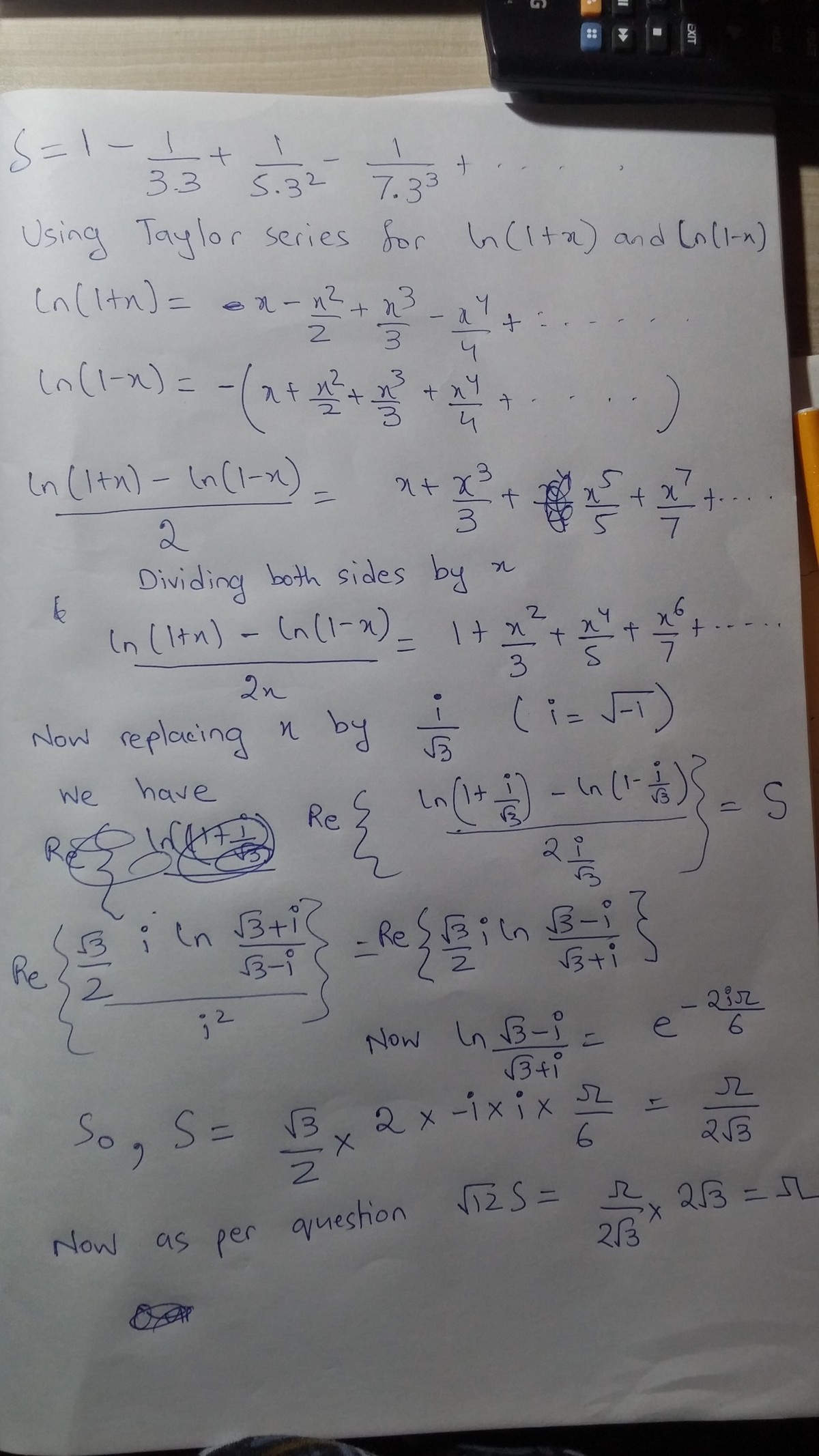Find this sum, if you can
S = 1 − 3 ⋅ 3 1 + 5 ⋅ 3 2 1 − 7 ⋅ 3 3 1 + ⋯
Find the value of 1 2 × S up to 2 decimal places.
The answer is 3.14.
This section requires Javascript.
You are seeing this because something didn't load right. We suggest you, (a) try
refreshing the page, (b) enabling javascript if it is disabled on your browser and,
finally, (c)
loading the
non-javascript version of this page
. We're sorry about the hassle.
4 solutions
@Jasper Braun Great solution!!!! (+1)
Consider the Macluarin series for tan − 1 x .
tan − 1 x tan − 1 3 1 3 tan − 1 3 1 = x − 3 x 3 + 5 x 5 − 7 x 7 + . . . = 3 1 − 3 ( 3 ) 3 1 + 5 ( 3 ) 5 1 − 7 ( 3 ) 7 1 + . . . = 1 − 3 ⋅ 3 1 + 5 ⋅ 3 2 1 − 7 ⋅ 3 3 1 + . . . = S Putting x = 3 1 Multiplying both sides with 3
⟹ 1 2 S = 1 2 ⋅ 3 tan − 1 3 1 = 6 ⋅ 6 π = π ≈ 3 . 1 4
I did it using complex analysis of taylor seires for ln(1-x) . Please download and zoom in the picture to see clearly and the picture quality is HDR so it is quite clear.
 {: .cente
{: .cente
We can get this sum through some manipulation of the Maclaurin series for arctan x (Derivation below), which is arctan x = x − 3 x 3 + 5 x 5 − ⋯ . Dividing both sides by x , we get x arctan x = 1 − 3 x 2 + 5 x 4 − ⋯ . Finally, by substituting x = 3 1 , we get S = = = 1 − 3 × 3 1 + 5 × 3 2 1 − 7 × 3 3 1 + ⋯ 3 1 arctan ( 3 1 ) 6 3 π Hence, 1 2 × S = π . QED.
Do note that this solution works because the substitution we used here is in the range ( − 1 , 1 ) (this is also known as the radius of convergence of the series). Now the derivation of the Maclaurin series for arctan x . Consider arctan x = = = ∫ 0 x 1 + t 2 1 d t ∫ 0 x ( 1 − x 2 + x 4 − x 6 + ⋯ ) d t ( By Binomial expansion, and ∣ t ∣ < 1 ) x − 3 x 3 + 5 x 5 − 7 x 7 + ⋯ , ∣ x ∣ < 1 . The derivation is complete.
Rewriting as 1 + n = 1 ∑ ∞ − ( 4 n − 1 ) 3 2 n − 1 1 + ( 4 n + 1 ) 3 2 n 1 =
1 + n = 1 ∑ ∞ ∫ 0 1 9 n y 4 n − 2 d y + 9 n y 4 n d y =
Then since the integral and sum are with respect different variables, they can be switched and the sums evaluated with 0 < y < 1
1 + ∫ 0 1 ( n = 1 ∑ ∞ 9 n − y 4 n − 2 + 9 n y 4 n ) d y =
1 + ∫ 0 1 9 − y 4 y 4 − 3 y 2 d y = 2 3 π
2 3 1 2 π = π